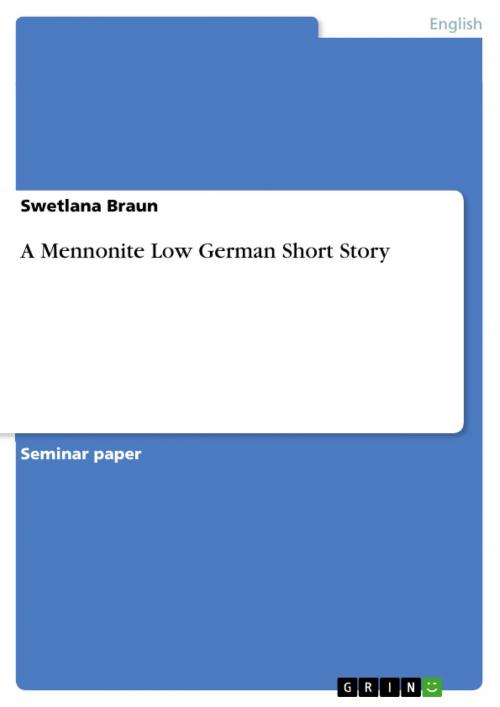| Author: | Swetlana Braun | ISBN: | 9783638055444 |
| Publisher: | GRIN Publishing | Publication: | May 29, 2008 |
| Imprint: | GRIN Publishing | Language: | English |
| Author: | Swetlana Braun |
| ISBN: | 9783638055444 |
| Publisher: | GRIN Publishing |
| Publication: | May 29, 2008 |
| Imprint: | GRIN Publishing |
| Language: | English |
Seminar paper from the year 2007 in the subject English Language and Literature Studies - Linguistics, grade: 1,3, Bielefeld University, course: English as a Global Lingua Franca, 7 entries in the bibliography, language: English, abstract: The approach of this paper is it to present the Mennonite Low German dialect and to develop an easily intelligible orthography for the mentioned dialect. In the first point the roots of the Low German dialect under examination are highlighted and it is shown that it belongs to the same family as the English language. Both varieties belong to the Indo-European languages or, more precisely, to its West-Germanic branch. Then, point two explains where the term Mennonite Low German comes from by unrolling the history of the Mennonites, their moves and their linguistic history. In terms of definition there is a further question that has to be tackled, namely whether Mennonite Low German is a language or a dialect. This question will be discussed in point three, bearing in mind the four criteria Petyt names to decide whether a variety is a language or a dialect. After having explained and linguistically discussed the term Mennonite Low German, I present my grandmother's short story and use it to develop Mennonite Low German orthography, which will be expounded in the fifth paragraph. The mentioned paragraph is subdivided into four points, of which the first one discusses Mennonite Low German orthography, its tries and problems. As most of the Mennonite Low German speakers are familiar with High German (but not with other Low German dialects), the Mennonite Low German orthography presented in this paper will follow several characteristics of German orthography, when considered as useful. Moreover, a short sketch of Mennonite Low German phonology and morphology will be provided in the following subparagraph in order to round off the topic. A short overview of the variations of the dialect under examination can be found in point 5.3; namely the Molotschna and the Old Colony accents. The last subparagraph deals with Mennonite Low German loan words and recent word formation. This variety contains several loan words that come from Dutch, Russian or German, for example. Paragraph number six explains the death of a former Lingua Franca, which Low German had been at the time of the Hanseatic League. The decline of Low German might also explain the underestimation of its dialect Mennonite Low German.
Seminar paper from the year 2007 in the subject English Language and Literature Studies - Linguistics, grade: 1,3, Bielefeld University, course: English as a Global Lingua Franca, 7 entries in the bibliography, language: English, abstract: The approach of this paper is it to present the Mennonite Low German dialect and to develop an easily intelligible orthography for the mentioned dialect. In the first point the roots of the Low German dialect under examination are highlighted and it is shown that it belongs to the same family as the English language. Both varieties belong to the Indo-European languages or, more precisely, to its West-Germanic branch. Then, point two explains where the term Mennonite Low German comes from by unrolling the history of the Mennonites, their moves and their linguistic history. In terms of definition there is a further question that has to be tackled, namely whether Mennonite Low German is a language or a dialect. This question will be discussed in point three, bearing in mind the four criteria Petyt names to decide whether a variety is a language or a dialect. After having explained and linguistically discussed the term Mennonite Low German, I present my grandmother's short story and use it to develop Mennonite Low German orthography, which will be expounded in the fifth paragraph. The mentioned paragraph is subdivided into four points, of which the first one discusses Mennonite Low German orthography, its tries and problems. As most of the Mennonite Low German speakers are familiar with High German (but not with other Low German dialects), the Mennonite Low German orthography presented in this paper will follow several characteristics of German orthography, when considered as useful. Moreover, a short sketch of Mennonite Low German phonology and morphology will be provided in the following subparagraph in order to round off the topic. A short overview of the variations of the dialect under examination can be found in point 5.3; namely the Molotschna and the Old Colony accents. The last subparagraph deals with Mennonite Low German loan words and recent word formation. This variety contains several loan words that come from Dutch, Russian or German, for example. Paragraph number six explains the death of a former Lingua Franca, which Low German had been at the time of the Hanseatic League. The decline of Low German might also explain the underestimation of its dialect Mennonite Low German.















